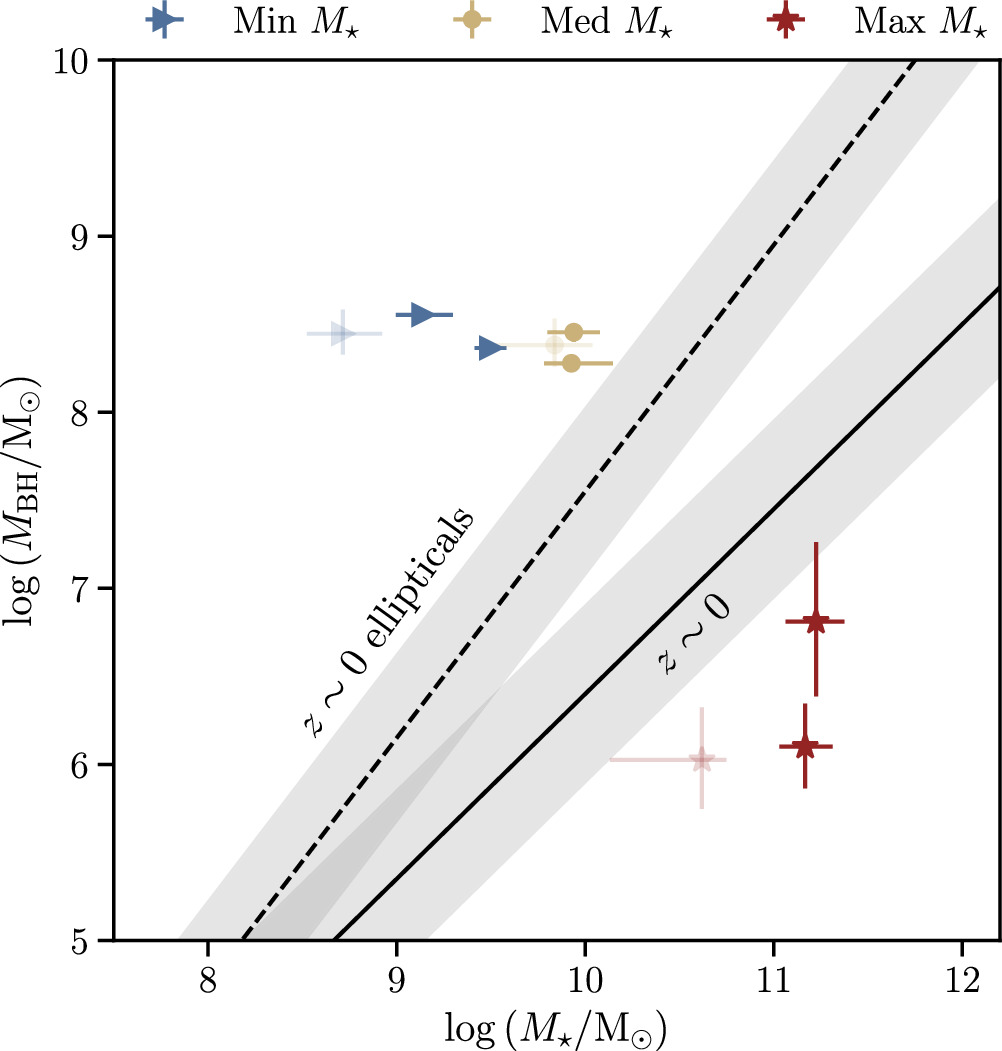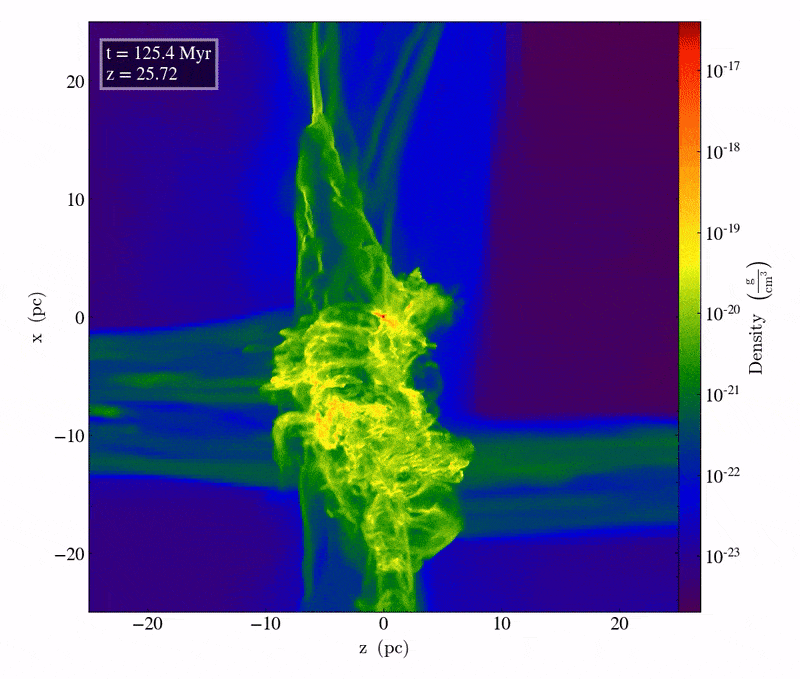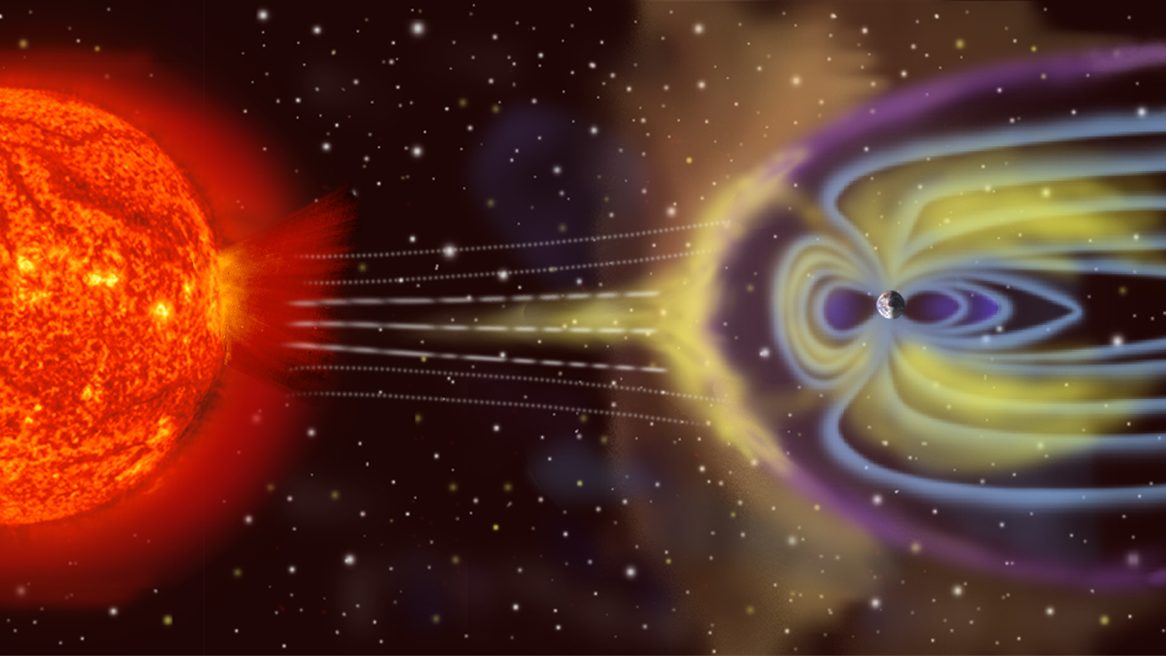Ask Ethan: Did black holes form directly from the Big Bang?

- As far back as we’ve been able to see galaxies and quasars, we see them appearing with supermassive black holes at their centers: millions or even billions of solar masses when the Universe was a tiny fraction of its current age.
- One idea that’s long fascinated theorists is the possibility of primordial black holes: black holes that were formed directly in the aftermath of the Big Bang, before any stars, galaxies, or even neutral atoms formed.
- While a few favor that idea, there are many reasons to think that much more mundane astrophysics, driven by collapsing normal matter, is responsible for these supermassive behemoths. Here’s the science behind why.
Some of the most impressive objects in our Universe are supermassive black holes. Weighing in at millions, billions, or even tens of billions of solar masses, they’re the heaviest single objects contained within the known Universe. One of the great problems in modern astrophysics is the open question of how they formed and grew up, and in many ways, the dawn of the JWST era has only intensified that problem. Looking back toward the dawn of time, we find supermassive black holes existed even very early on, reaching hundreds of millions or even a billion solar masses by the time only a few hundred million years had elapsed: when the Universe was just a few percent of its current age.
Was it just plain old astrophysics that led to their creation, with nothing special happening to seed them? Or is it possible that the Universe was actually born with “seed” black holes that would rapidly grow into the supermassive behemoths we observe much later on? That’s what Predrag Branković wants to know, writing in to inquire:
“Did you see this [article]? Is it possible that those black holes actually came to existence as a direct consequence of [the Big Bang]?”
The article in question isn’t exactly about black holes in the early Universe, as it’s rather about the star-formation history of some early galaxies seen by JWST, but there is one relevant plot that we can look at as our starting point: a plot of the inferred black hole masses in these early galaxies (from when the Universe was around 5% of its current age) versus the total mass inferred to be in the form of stars. Let’s start there.

The reason this graph is important is because, in these early galaxies, we have ways of approximating two quantities at the same time:
- the total amount of mass that’s present in the form of stars within these galaxies,
- and the total amount of mass that’s estimated to be located in the supermassive black holes within these galaxies.
This graph shows, for a set of galaxies, three estimates: blue (where stellar mass is minimized), yellow (where stellar mass is in the middle), and red (where stellar mass is maximized). As you can tell by the span between the blue, yellow, and red points, the uncertainties are large, and we cannot pinpoint the mass present in either stars or a supermassive black hole very well at these early times.
However, the blue and yellow points raise an important possibility: that the mass of the black holes represents a significant fraction of the mass present in stars. For the blue points, that ratio is as high as 10-30%; for the yellow points, that ratio is a more modest 2-5%, and for the red points, that ratio is way down at around 0.001-0.006%. The reason the blue and yellow possibilities are important is that today, when we plot the more typical black hole-to-stellar mass ratio of galaxies, as shown in the gray shaded regions, we get a value that’s more typically around 0.1%, indicating that earlier on, galaxies may have had more massive black holes compared to the amount of stars inside.

Take, for example, the black hole at the center of the galaxy Messier 87: one of the largest, most massive, and brightest galaxies within 100 million light-years of our own. It contains within it an enormous supermassive black hole: one that weighs in at 6.5 billion solar masses, or some ~1500 times as massive as the Milky Way’s largest black hole. But it also contains an enormous number of stars, around a trillion of them, with an estimated stellar mass of around 2.4 trillion solar masses. The supermassive black hole-to-stellar mass ratio for this galaxy, which contains the largest supermassive black hole in our vicinity, still only comes in at a paltry 0.27%.
If central, supermassive black holes and galaxies formed together and grew up together, we’d expect that ratio to remain relatively constant over time: as galaxies grow and grow, so would their supermassive black holes, keeping pace with one another. However, the possibility that many would love to consider — including this week’s question-asker — is that perhaps the Universe didn’t form early black holes and early stars concurrently, and that those two components of the galaxy grew up together. Instead, perhaps the Universe was born with a set of primordial black holes, or black holes that formed in the immediate aftermath of the hot Big Bang, and then those black holes served as “nucleation sites” for galaxies to form around and grow.

However, there are two other ways to make black holes in the Universe that fall within the “standard history” scenario that don’t involve primordial black holes — or black holes formed in the immediate aftermath of the Big Bang — at all, but merely conventional astrophysics. Instead of being born with black holes, the Universe could have simply been born with normal, slight density imperfections: tiny fluctuations that result in initially overdense and underdense regions. Those overdense regions could slowly grow, attracting more and more matter, until one of two things occur.
- Stars can form from this matter, resulting in massive stars that burn through their fuel quickly and die, with their cores collapsing and resulting in “seed” black holes of tens, hundreds, or maybe even up to a thousand solar masses.
- Or, cold streams of gas can fall into these overdense regions and collide with one another, which could form stars like normal. Alternatively, however, it could lead to a phenomenon known as direct collapse: where the matter becomes dense enough in a small enough volume of space that black holes can directly form, leading to a population of much heavier black hole seeds: seeds in the range of tens of thousands or even hundreds of thousands of solar masses.
The first one definitely happens, but the second one could happen as well, and requires no “new physics” to trigger it, unlike the primordial black hole scenario.

Although it might not seem like a big deal, the difference between:
- a primordial black hole,
- a stellar mass black hole,
- and a heavy seed formed via direct collapse,
is extremely significant. When we’re looking at galaxies in the very early Universe, we’re seeing the Universe as it was an incredibly long time ago: more than 90% of the Universe’s history ago. Even back prior to the JWST era, we were finding galaxies with large, massive black holes that were comparable to a billion solar masses from when the Universe was between 650 and 800 million years old: just 5-6% of its current age.
Now, in order for a black hole to get that big that fast, it must have grown up quickly. Based on the physics that we know, there’s a limit to how quickly a black hole can grow from devouring matter: the Eddington limit. (Yes, super-Eddington rates are possible, but only by slight amounts, and not over sustained periods of time.) If we extrapolate from the black holes we observe at those early times, but not super-early times, back to the very early Universe, we find that if we go back to when we expect the first stars to form and the first streams of cold gas to collide, we’re looking at time periods when the Universe was just 50 to 150 million years old, and we can infer the size-and-mass of the seeds we need.

It turns out that one of the options — to invoke standard astrophysics and stellar mass black hole seeds, also known as “light seeds” — is ruled out by the data. The situation only worsened in the JWST era, as the record for earliest supermassive black hole was pushed back earlier and earlier.
- In July of 2023, JWST researchers from the CEERS collaboration reported the discovery of CEERS 1019, which contains a black hole of 9 million solar masses from an age of 570 million years, representing ~1% of the stellar mass inside the galaxy.
- Then, a few months later, a galaxy known as UHZ1 was found, at an age of 470 million years, with a rather large black hole mass of 10-100 million solar masses, but with a small stellar mass content also between 10-100 million solar masses, where the black hole is 10-100% of the stellar mass content of the galaxy.
- And galaxy GN-z11, as shown in January of 2024, contains a supermassive black hole of 1.5-3.0 million solar masses just 420-440 million years after the Big Bang, although its stellar mass content is large, at close to 1 billion solar masses, and it appears to be undergoing super-Eddington accretion right now.
In other words, what we’re seeing suggests a mix of light and heavy seeds as the origin of supermassive black holes, but doesn’t suggest a need for even earlier, truly primordial black holes.

Seeds of 10,000 to 100,000 solar masses are completely sufficient for everything we see, even if those initial black hole seeds didn’t arise until up to ~150 million years after the Big Bang. The direct observation of what we call “overmassive” (or, in some corners, “outsized”) black holes, however, such as UHZ1 and also as suggested (more weakly) by the more recent RUBIES paper, rules out the “light seed” scenario very thoroughly, as a team led by Fabio Pacucci predicted would occur back in 2017.
If you begin with heavy black hole seeds that are driven by cold streams of colliding gas, and forming via a direct collapse mechanism, you’d expect to find overmassive black holes early on, and you’d expect that to be the norm:
- with black hole to stellar mass ratios of ~10-100% in early, low-mass galaxies,
- of ~1-10% later on in more massive, more evolved galaxies,
- of ~0.1-1% in still more evolved galactic populations,
- and then declining to the more standard ~0.1%, as seen in present-day galaxies.
In a compilation of JWST-observed galaxies from the first 1.5 billion years of cosmic history, Pacucci’s team was able to show precisely this predicted evolutionary trend, using galaxies primarily extracted from JWST’s CEERS, JADES, and GLASS observing programs. Although there are still uncertainties on these values, they strongly suggest a “heavy seed” formation mechanism, as the below graph illustrates.

So what, then, of the primordial black hole scenario?
The issue is twofold: if you want to form primordial black holes, your Universe needs to be born with enormous-magnitude overdensities, or regions where the density is more than ~68% greater than the cosmic average density. If you have a region that’s more overdense than that, you can prove that it will, in fact, collapse rapidly to form a black hole, and that’s the primary scenario by which you can form primordial black holes that will persist until the present day.
Unfortunately, there are two reasons that such a scenario is strongly disfavored. The first comes from direct observations of the Universe, which give us a series of constraints concerning how much matter, out of the total amount of normal-and-dark matter combined, is allowed to be in the form of primordial black holes of varying masses.
- At low masses (below the mass of a typical large asteroid), black holes that were born at the start of the hot Big Bang would have evaporated, and the lack of that evaporative radiation rules them out.
- From about moon-mass objects to brown dwarf masses, direct searches for microlensing events rule out more than ~a few percent of the mass being in the form of black holes.
- But for heavier masses, from the lowest stellar masses on upward, the lack of gravitational wave signals, the lack of accretion signals, and the lack of features appearing in the CMB (the cosmic microwave background) strongly constrain the abundance and presence of these heavier-mass primordial black holes.

If we wanted to create primordial black holes that were great enough in mass to serve as seeds for the black holes we observe in the late-time Universe, they would have to be at least ~100 solar masses in magnitude back when they were first created. However, that’s just about the threshold that would mess up the fluctuations in the cosmic microwave background; it’s a very challenging scenario to create them.
But there’s a second, arguably even stronger reason to disfavor the emergence of a large population of primordial black holes. Remember, to create a black hole primordially, in the aftermath of the Big Bang, you need an enormous initial overdensity: something that’s ~68% greater in density than average. But we already know the spectrum of overdensities in the Universe from cosmic inflation: it has a large-scale amplitude of just ~0.003%, and that amplitude drops as we move to smaller and smaller cosmic scales.
The only way to produce such a population is with a finely-tuned phase transition. This transition could have occurred:
- at the end of inflation,
- at the electroweak scale (electroweak symmetry breaking),
- during the formation of protons and neutrons (the QCD phase transition),
- or during some yet-undiscovered transition later on.
However, this requires that we have a “spike” of giant magnitude overdensities (~68% or more) at one particular mass, and then at all other scales, the overdensities are just of that standard ~0.003% value. It’s not only a highly constrained scenario from observations, it’s one where you have to contort your theory tremendously to produce the primordial population of black holes you desire.

So, at the end of the day, could the supermassive black holes we see have arisen from a population of primordial black holes that sprang into existence in the extremely early stages of the hot Big Bang?
The real answer is that it’s a scenario that is neither supported nor favored by the data, but that isn’t completely ruled out just yet, either. It is plausible that higher-resolution studies of the CMB can place stronger constraints on such a scenario, but the most promising line of evidence to find out for sure will be to push the cosmic limits even farther: looking for galaxies with black holes in them even earlier in the Universe’s history, from the first 150-400 million years. If the “heavy seed” scenario is the right one, this should be the place to look to confirm it. JWST might be able to help, but deep observations in other wavelengths of light, such as X-ray wavelengths, would be ideal. With no successor to NASA’s Chandra currently moving forward, and with Chandra facing what can only be called a penny-pinching death, this is presently a fairly dim prospect.
However, the truth is that primordial black holes aren’t needed to explain what we see; heavy seeds formed by the direct collapse of normal matter much, much later on, after tens or even hundreds of millions of years, could be all that it takes to create the supermassive black holes we find much later on. Although we have to always be careful when drawing conclusions based on incomplete data while simultaneously remaining open to all the possibilities that are not yet ruled out, the true answer is that primordial black holes are wholly unnecessary to explain what we observe. The black holes that we see, in all likelihood, arose much later on in cosmic history than shortly after the Big Bang.
Send in your Ask Ethan questions to startswithabang at gmail dot com!





